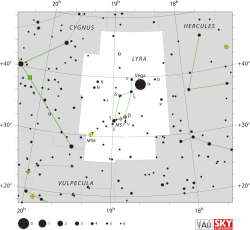Gamma Lyrae
| Observation data Epoch J2000 Equinox J2000 | |
|---|---|
| Constellation | Lyra |
| Right ascension | 18h 58m 56.62241s[1] |
| Declination | +32° 41′ 22.4003″[1] |
| Apparent magnitude (V) | 3.261[2] |
| Characteristics | |
| Spectral type | B9 III[3] |
| U−B color index | –0.125[2] |
| B−V color index | –0.047[2] |
| Absolute magnitude (MV) | −3.14[5] |
| Details | |
Rotational velocity (v sin i) | 71–72[7] km/s |
| Database references | |
| SIMBAD | data |
Gamma Lyrae,
interstellar dust.[6]
Nomenclature
γ Lyrae (Latinised to Gamma Lyrae) is the star's Bayer designation.
It bore the traditional names Sulafat (Sulaphat), from the
Working Group on Star Names (WGSN)[12] to catalogue and standardize proper names for stars. The WGSN approved the name Sulafat for this star on 21 August 2016 and it is now so entered in the IAU Catalog of Star Names.[10]
In
Chinese name
for Gamma Lyrae itself is 漸台三 (Jiāntāisān, English: the Third Star of Clepsydra Terrace).
Properties
This is a
radius of the Sun.[17]
In 1909, Canadian astronomer
absorption lines of the components. He found that a period of 25.6 days matched his measurements.[18] It was reported as a spectroscopic binary as recently as 2001,[19] but is now believed to be a single star[20][21] with a high rate of rotation for stars of this type.[19]
References
- ^ S2CID 18759600
- ^ Bibcode:1986A&AS...65..405O
- ^ doi:10.1086/110819
- Bibcode:1967IAUS...30...57E
- S2CID 119257644.
- ^ S2CID 14624307.
- S2CID 14070763
- Centre de Données astronomiques de Strasbourg, retrieved 2012-01-12
- ISBN 978-1-931559-44-7.
- ^ a b "IAU Catalog of Star Names". Retrieved 28 July 2016.
- ^ Allen, Richard Hinckley (1899), Star-names and their meanings, G. E. Stechert, p. 287
- ^ IAU Working Group on Star Names (WGSN), International Astronomical Union, retrieved 22 May 2016.
- ^ (in Chinese) AEEA (Activities of Exhibition and Education in Astronomy) 天文教育資訊網 2006 年 7 月 3 日
- Commonwealth Scientific and Industrial Research Organisation, December 21, 2004, archived from the originalon 2012-03-18, retrieved 2012-01-16
- ISBN 3-540-29692-1. The radius (R*) is given by:
- doi:10.1086/141699
- ^
- S2CID 10416471
- S2CID 14878976
External links
- Kaler, James B., "SULAFAT (Gamma Lyrae)", Stars, University of Illinois, retrieved 2012-01-12


